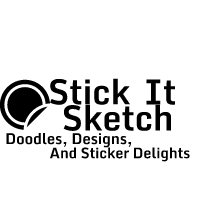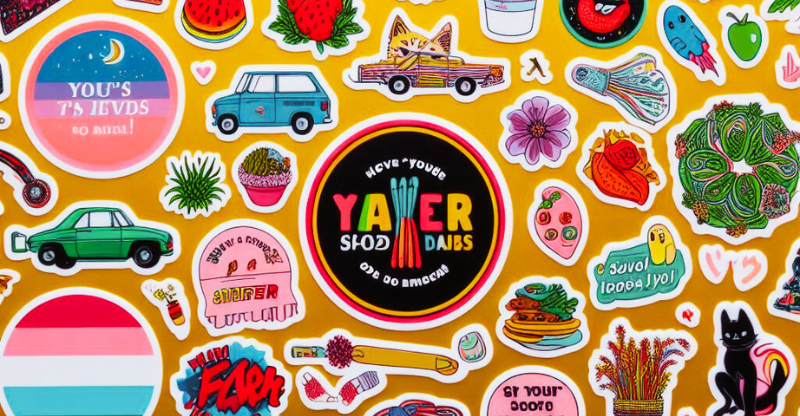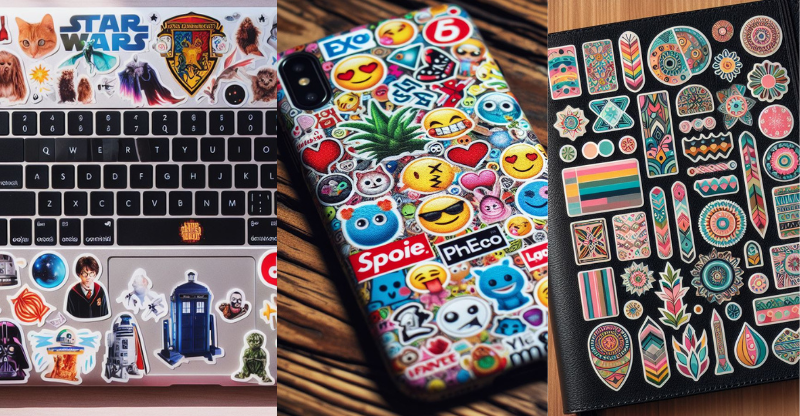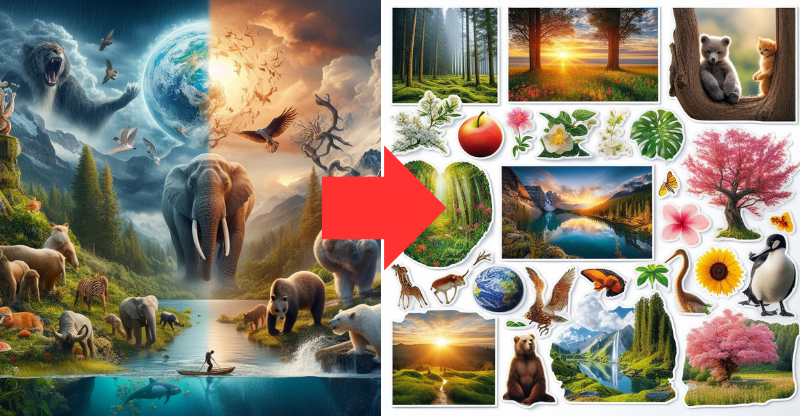Vinyl stickers are a versatile and popular form of personalization and branding, favored for their durability and ease of use. They consist of a material known as vinyl, which is a synthetic resin or plastic that is known for its resistance to moisture and environmental wear and tear. This resilience makes vinyl stickers an ideal choice for both indoor and outdoor applications, ensuring that whether they’re placed on cars, laptops, or storefronts, they maintain their integrity and appearance over time.

The process of customizing vinyl stickers involves a variety of options that cater to the individual needs of consumers or businesses. Customers can design their own stickers with personalized graphics or messages, and choose from a range of sizes, shapes, and colors to match their specifications. Businesses leverage this customizability to create branded, personalized decals that serve as a valuable marketing tool. The end product is produced using specialized machinery, ensuring high-quality print resolution and adhesive strength that stands up to frequent handling and harsh conditions.
Key Takeaways
- Vinyl stickers offer exceptional durability and are suitable for a range of surfaces.
- Personalization options for vinyl stickers are extensive, accommodating a myriad of design preferences.
- They are a cost-effective marketing tool for businesses seeking to increase brand visibility.
Understanding Vinyl Stickers

Vinyl stickers are a popular medium for personal expression and branding, known for their durability and versatility. They are ideal for both personal and commercial applications, offering a variety of types to suit different needs.
Different Types of Vinyl Stickers
Permanent Vinyl Stickers: These are designed for long-term use, often utilized for outdoor signage, vehicle decals, and product labeling. They are made with a strong adhesive that is not meant to be removed without potentially damaging the surface.
Removable Vinyl Stickers: Unlike their permanent counterparts, these stickers can be easily taken off without leaving residue. They are perfect for temporary promotions, seasonal decorations, wall decals, or applications on sensitive surfaces.
Both types come with a choice of finishes such as glossy or matte laminate, enhancing the sticker’s appearance and adding a layer of protection.
Quality and Durability Factors
The quality of a vinyl sticker is determined by several factors like the vinyl material’s thickness, the type of adhesive used, and the quality of the print. High-quality vinyl is typically thicker, providing a durable surface that withstands environmental elements like UV rays and rain. A glossy laminate can shield the clear vinyl sticker from scratches and fading, while a matte finish can reduce glare and give a sophisticated look.
Durability also extends to the sticker’s lifespan which can range from a few months to several years depending on the type and quality of vinyl used.
Other Materials vs Vinyl
Vinyl stickers are often compared to other materials such as paper labels or magnetic clings. Vinyl decal quality generally surpasses paper as it is waterproof and fade-resistant. Unlike magnetic cling options, vinyl material does not require a metallic surface, allowing for a wider range of application. Furthermore, vinyl stickers tend to provide a better color contrast and sharper image due to the quality of print they can support.
Designing Your Vinyl Stickers

Creating custom vinyl stickers involves careful consideration of size, shape, and design elements to ensure the final product meets the intended aesthetic and functional requirements.
Selecting the Right Size and Shape
When designing vinyl stickers, selecting the appropriate size is crucial for the sticker’s intended use. Sizes can range from small decals for phones to larger ones suitable for vehicles or storefronts. The shape of the sticker also plays a vital role in the overall appearance; common shapes include:
- Round
- Oval
- Square
- Rectangle
- Custom Shapes (Die cut)
Die-cut stickers are custom shaped to fit the outline of the design or logo, providing a unique and tailored look.
Choosing Colors and Graphics
Color selection is paramount in sticker design, as it impacts visibility and compatibility with the surface where the sticker will be applied. It’s advisable to use:
- High-contrast colors for better visibility.
- Complementary colors that align with brand standards if incorporating a logo.
Graphics should be high-resolution to avoid pixelation when printed. For a coherent design, one should consider:
- The complexity of the graphics in relation to sticker size.
- How legibility may be affected once printed.
Sticker sheets offer the opportunity to include multiple designs or variations of a logo, which can be especially useful for branding purposes.
Customization Options

Custom stickers offer a versatile and effective way to communicate a message or bolster brand recognition. They come in various materials, with custom vinyl stickers standing out due to their durability and adaptability to many surfaces.
Creating Custom Decals
For individuals looking to express themselves or add a personal touch to their belongings, creating custom decals is a straightforward process. Custom vinyl decal options allow for a high degree of personalization, from choosing specific sizes to intricate designs. They can feature favorite images, quotes, or artwork, and utilize a full CMYK color palette for vibrant prints. Tools offered by services like Stickers.com simplify the design process, making it accessible for everyone.
Personalizing for Brands and Businesses
Businesses can leverage personalized stickers to enhance their marketing materials. When personalizing stickers for brands, businesses often include their business name and logo which contributes to increased visibility and brand consistency. Made-to-order items like vinyl stickers from VistaPrint can serve multiple functions: as giveaways, product labeling, or as part of a larger marketing campaign. Customization allows companies to tailor stickers to their branding guidelines, employing shapes and sizes that resonate with their audiences and fit their unique needs.
Materials and Adhesives

When it comes to vinyl stickers, selecting the appropriate materials and adhesives is crucial. The durability, appearance, and application of the stickers largely depend on these choices.
Choosing the Right Laminate
A laminate is a protective film applied over the graphic layer of a sticker, which can be either glossy or matte. A glossy laminate offers a shiny finish that enhances colors, making them pop and providing additional UV protection. On the other hand, a matte laminate gives a subdued, modern aesthetic and reduces glare, which can be preferable for reading in various lighting conditions. The decision between the two finishes should be guided by both the sticker’s intended use and aesthetic goals.
Adhesive Types: Permanent vs Removable
Adhesive type is a critical aspect that dictates how a sticker can be used. When a sticker needs to stay in place indefinitely or under harsh conditions, a permanent adhesive is the best choice. It provides very high quality and high bonding strength but may damage surfaces upon removal.
- Permanent Adhesive:
- Bond Strength: High
- Durability: Excellent
- Removal: Difficult, may leave residue
Conversely, if there’s a possibility of needing to remove or reposition the sticker without leaving residue, a removable adhesive is recommended. Removable adhesives offer flexibility for applications where temporary positioning is needed or where no surface damage is essential.
- Removable Adhesive:
- Bond Strength: Moderate
- Durability: Good
- Removal: Clean, residue-free
Choosing between permanent and removable adhesives impacts both the sticker’s usability and the longevity of the surface onto which it’s applied. Whether for promotional purposes or personal use, understanding the nuances between different laminates and adhesives ensures that the vinyl stickers not only look high quality but also perform optimally for their intended purpose.
Production and Manufacturing

Vinyl stickers are an amalgamation of precision and quality, involving detailed printing and cutting processes. Each step ensures a high-quality vinyl decal that meets customer specifications.
The Printing Process
The printing process for vinyl stickers begins with selecting a suitable vinyl material, which is known for its durability and flexibility. State-of-the-art digital printing technology then transfers the design onto the vinyl. This phase is critical as it determines the vibrancy and sharpness of the final product. The inks used are typically weather-resistant, ensuring that the stickers retain their quality even when exposed to the elements.
Cutting Techniques
After printing, stickers are shaped using various cutting techniques. Die cut stickers are precision-cut into custom shapes to fit the design perfectly, allowing for intricate borders and patterns. This method is preferred for high-quality decals, as it provides a clean, professional finish. Another popular method is kiss cutting, where the sticker is cut only through the vinyl layer and not the backing paper, making it easier to peel and apply the stickers. The accuracy of the cutting process is paramount to ensure that each sticker is consistent and meets the design specifications.
Using Vinyl Stickers

Vinyl stickers offer versatility and durability, making them suitable for a range of applications across different surfaces. When applied correctly and maintained, they can be a waterproof and lasting decoration or labeling solution.
Application on Different Surfaces
Vinyl stickers can adhere to various surfaces such as glass, metal, plastic, and wood. The surface should be clean and at a moderate temperature for optimal adhesion. For instance, when applying vinyl stickers for water bottles, it is imperative to ensure that the bottle is dry and free from grease for the sticker to be waterproof and withstand regular handling. Surfaces with curves or textures may require special techniques for a smooth application.
- Glass and Metal: These non-porous surfaces are ideal for vinyl stickers, providing a smooth and waterproof finish with strong adhesion.
- Plastic: Compatibility varies, so it’s advisable to check the specific type of plastic against the adhesive properties of the sticker.
- Wood: Application on wood requires that the wood is sealed or treated to provide a surface that mimics the smoothness of glass or metal.
Maintenance and Care
To prolong the life of vinyl stickers and maintain their appearance, gentle cleaning is recommended. The following table outlines the basic maintenance steps based on the surface:
| Surface | Cleaning Method | Additional Care Tips |
|---|---|---|
| Glass | Mild soap and water, soft cloth. | Avoid abrasive tools that can scratch the sticker. |
| Metal | Warm water, gentle detergent, non-abrasive cloth. | Clean regularly to prevent buildup that could interfere with adhesion. |
| Plastic | Soft cloth, soapy water (if applicable). | Test cleaners on an inconspicuous area to prevent damage. |
| Wood | Damp cloth, avoid soaking the wood. | Ensure wood is dry before application to prevent peeling. |
For longevity, keep vinyl stickers out of direct sunlight when possible and avoid high-pressure washing, as it can cause the edges to lift and peel. With proper care, these durable vinyl stickers can be a long-lasting option for personalizing and labeling a variety of items.
Purchase and Distribution

This section provides insight into the strategic procurement of premium vinyl stickers and the financial considerations of bulk buying. Effective planning in these areas can greatly benefit small businesses and creative entrepreneurs in the global marketplace.
Finding the Best Suppliers
A reliable supplier can significantly impact a business’s ability to offer the highest quality material for vinyl stickers. Small businesses and creative entrepreneurs should focus on suppliers who can provide a range of designs and customization options. It’s not uncommon to find suppliers who offer free shipping to cater to a more global marketplace. One example is Vinyl Sticker Factory, which caters to wholesale sticker needs at competitive prices and provides free shipping.
Order Quantity and Pricing
Order quantity and pricing are intertwined, with bulk orders typically resulting in a lower cost per unit. Small businesses must balance the benefits of lower per-item costs with the risk of overstocking. For instance, purchasing stickers from suppliers like 48HourPrint, businesses can order up to 100,000 stickers which helps in leveraging economies of scale. Quantity tiers might look like the following:
- Small Quantity Orders:
- 25-200 units often applied by hand
- Higher cost per sticker
- Bulk Quantity Orders:
- 250+ units, suitable for extensive distribution
- Reduced cost per sticker (e.g., 250 stickers at $0.75 each, 1000 stickers at $0.19 each)
Understanding the needs of their customer base and anticipated sales volume ensures that businesses do not purchase too many or too few stickers, optimizing their investment in stock.
The Market for Vinyl Stickers

The vinyl sticker market has experienced consistent growth, fueled by diverse applications and the drive for personalization in various consumer segments.
Support for Indie Brands and Artists
Independent brands and artists have found a strong ally in the vinyl sticker industry. These stickers often serve as a form of expression and branding for handmade pieces, allowing creators to showcase their unique style and vision. Additionally, consumer support for indie artists is bolstered by the purchase of custom stickers, contributing to a vibrant and personalized ecosystem of vintage treasures and craft supplies.
Noteworthy Points:
- Reviews: Customer testimonials are pivotal, guiding purchasing decisions and enhancing brand credibility.
- Sales Channels: Both online and offline outlets have been crucial for artists to reach a broader audience.
Evolving Trends in Sticker Use
Vinyl stickers are not only popular among artists, but have also become a key marketing tool for businesses. Their durability makes them suitable for both indoor and outdoor applications, leading to an expanding presence on personal devices, vehicles, and storefronts. The trends point toward a growing preference for personalized and customized vinyl stickers, with digital items also gaining traction as consumers look for easy ways to express their identities in the virtual and physical spaces they occupy.
Key Aspects:
- Consumer Demand: Driven by a desire for unique aesthetics and individualism.
- Functionality and Quality: The use of thick, weatherproof vinyl ensures stickers remain vibrant and intact against various environmental factors.
Frequently Asked Questions

In this section, readers will find answers to common inquiries about vinyl stickers, addressing customizations, ideal surfaces for application, durability, printing processes, removal techniques, and material differences.
How can vinyl stickers be customized for personal or business use?
Vinyl stickers can be tailored to an individual’s or business’s specific needs, offering a wide range of colors, designs, and sizes. Utilizing digital printing and precision cutting techniques, businesses can create branded vinyl stickers for marketing, while individuals might personalize items with unique decorations.
What surfaces are ideal for applying vinyl stickers?
They adhere best to smooth, non-porous surfaces such as glass, plastic, metal, and laminated wood. Surfaces should be clean and dry to ensure optimal adhesion and longevity of the sticker.
Are vinyl stickers durable in outdoor conditions and waterproof?
Vinyl stickers are highly durable and typically waterproof, making them suitable for indoor and outdoor use. They are designed to withstand exposure to elements such as rain, sunlight, and varying temperatures without fading or peeling.
What is involved in the process of printing high-quality vinyl stickers?
High-quality vinyl stickers are printed using advanced techniques such as eco-solvent or latex printing, which ensure vibrant colors and clarity. The stickers are then cut using precision machines, like plotters or die-cutters, to create intricate shapes and designs.
Can vinyl stickers be removed without leaving residue or damaging surfaces?
Vinyl stickers are generally removable without leaving residue, especially if they are designed for short-term use. For long-term decals, a heat source such as a hairdryer can be gently applied to ease the removal process and reduce the risk of surface damage.
What are the differences between regular stickers and vinyl stickers in terms of material and usage?
Vinyl stickers differ from regular paper stickers in their material composition and usage scenarios. Vinyl is a more flexible and durable material that is resistant to water and UV light, making it ideal for both indoor and outdoor applications. Paper stickers, on the other hand, are less durable and are typically used for indoor or temporary purposes.




